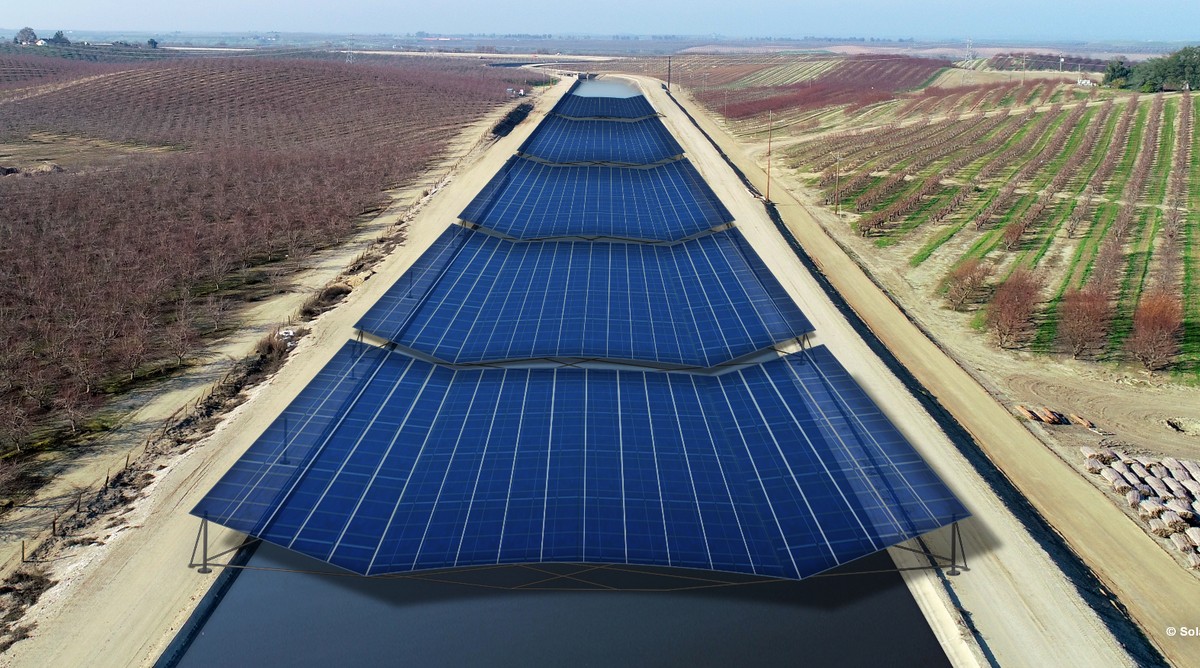
In March 2021, Electrek reported that scientists published a feasibility study about the benefits of erecting solar panels over canals. That study is about to become a reality when a pilot project breaks ground in California.
Solar over canals
August 26 update: Project Nexus in the Turlock Irrigation District, a $20 million project funded by the State of California, will break ground in mid-October at two locations:
- A 500-foot span of a canal in Hickman, east of Modesto
- A mile-long canal span in the nearby city of Ceres
Josh Weimer, Turlock Water & Power’s external affairs manager, said [via Reuters]:
If this is something that works on these first two miles of Project Nexus that we’re doing, there’s the potential that this could scale to multiple locations.
If all 4,000 miles of California’s canals were covered with solar panels, that could produce 13 gigawatts of renewable power. A gigawatt is enough to power 750,000 homes, so that would be enough power for 9.75 million households. For perspective, as of July 2021, there were 13.1 million households in California.
March 1: The California Department of Water Resources, utility company Turlock Irrigation District (TID), Marin County, California-based water and energy project developer Solar AquaGrid, and The University of California, Merced, are partnering on Project Nexus – a “nod to the water-energy nexus paradigm gaining attention among public utilities.”
India already has solar panels over canals, but the mile-long Project Nexus in California’s San Joaquin Valley will be the first of its kind in the US.
TID explains what the pilot is:
Project Nexus includes the installation of solar panel canopies over various sections of Turlock Irrigation District’s (TID) irrigation canals. Project Nexus will serve as a Proof of Concept to pilot and further study solar over canal design, deployment, and co-benefits on behalf of the State of California using TID infrastructure and electrical grid access.
The project is anticipated to break ground in fall 2022 and be complete by the end of 2024.
Project Nexus will provide the opportunity to see whether the solar panels reduce water evaporation as the result of midday shade and wind mitigation; create improvements to water quality through
reduced vegetative growth; reduce canal maintenance as a result of reduced vegetative growth; and
of course, generate renewable electricity.
Roger Bales, distinguished professor of engineering at the University of California, Merced, who is working on this project, wrote in the Conversation:
Most of California’s rain and snow falls north of Sacramento during the winter, while 80% of its water use occurs in Southern California, mostly in summer. That’s why canals snake across the state – it’s the largest such system in the world. We estimate that about 1-2% of the water they carry is lost to evaporation under the hot California sun.
In a 2021 study, we showed that covering all 4,000 miles of California’s canals with solar panels would save more than 65 billion gallons of water annually by reducing evaporation. That’s enough to irrigate 50,000 acres of farmland or meet the residential water needs of more than 2 million people. By concentrating solar installations on land that is already being used, instead of building them on undeveloped land, this approach would help California meet its sustainable management goals for both water and land resources.
Read more: Solar panels and California’s canals could make a winning pair
Photo: Robin Raj, Citizen Group & Solar Aquagrid
UnderstandSolar is a free service that links you to top-rated solar installers in your region for personalized solar estimates. Tesla now offers price matching, so it’s important to shop for the best quotes. Click here to learn more and get your quotes. — *ad.
FTC: We use income earning auto affiliate links. More.





Comments